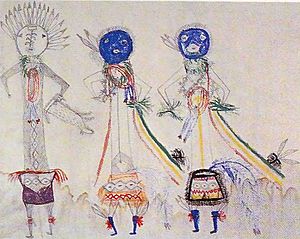Apie Begay facts for kids
Quick facts for kids
Apie Begay
|
|
|---|---|
| Nationality | Navajo Nation, American |
| Occupation | painter |
| Years active | early 20th century |
Apie Begay was a talented Navajo artist and painter. He lived and created art in the early 1900s. His home was near the Pueblo Bonito trading post in what is now New Mexico.
He was the first Navajo artist known to use European art supplies. These included crayons and colored pencils. His artwork has been shown in many places. You can find his paintings in museums like the Museum of New Mexico. The Fred Jones Jr. Museum of Art also has his work.
Apie Begay's Life
We do not know the exact year Apie Begay was born. His name, Begay Apie, means "Son of Milk."
In 1902, a researcher named Kenneth M. Chapman visited the Navajo area. He heard about an artist who spent his time creating art. Chapman was very interested. He searched for this artist and found Begay in his hogan. A hogan is a traditional Navajo home.
Begay was using red and black colors to make spiritual Navajo sandpaintings. Chapman gave him a box of crayons. This helped Begay use many more colors in his art. He quickly started using these new colors in his paintings.
Chapman later wrote about meeting Begay. He said a store clerk showed him some drawings by Begay. These were drawings of Navajo dance groups. Begay had made them with a pencil on cardboard. Chapman gave Begay good paper and lent him his colored pencils. These were the first colored pencils Begay had ever seen.
Begay made three drawings for Chapman. These are thought to be the first Navajo artworks made with "white man's materials." Begay created several artworks for Chapman. This was like a special order, or "commission." Some experts say this was the start of non-Native people supporting Native art.
We also do not know when Apie Begay died. Sources say he passed away many years before 1936.
Apie Begay's Art and Legacy
Many Navajo artists at that time were asked to change their art style. They were encouraged to make their art look more European. But Apie Begay did not change his style. He kept his traditional Navajo images and ways of painting.
Some art critics did not like this. For example, in 1973, Clara Lee Tanner wrote about Begay. She felt it was hard for an artist like him to use new tools and methods. But three years later, writer Jamake Highwater disagreed. He said Tanner's idea was "condescending." This means it was a bit rude or looked down on Begay.
By 2009, a scholar named Tom Holm called Begay "the father of modern Navajo painting." Begay's paintings were based on traditional Navajo culture. But he made them for people who were not Native. These works are seen as the start of "Native modernism." This means a new, modern way of Native art.


